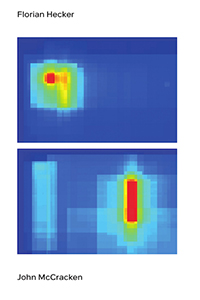An artistic dialogue between German artist and computer composer Florian Hecker, and the late American sculptor John McCracken.
Following the 2015 exhibition “Florian Hecker / John McCracken” at Künstlerhaus, Halle für Kunst & Medien Graz, this publication probes the experimental capacity of the white-cube space of the gallery. For the exhibition, two complementary yet autonomous artists were brought into dialogue with each other: German artist and computer composer Florian Hecker, and the late American sculptor John McCracken.
The fiberglass-coated, monochrome “planks” by McCracken spanned the floor and the walls of the building, evoking a juncture between painting and sculpture, while Hecker's computer-generated sound pieces dramatized both space and time. By combining the work of the two artists, a framework was created in which an aesthetic experience occurred between the shifting boundaries and intersections of sculpture and sound as they affected each other within a space consisting of geometric and architectural formations as well as temporal and subjective formations. At the same time, the viewer / listener became more sensitized to the conditions, qualities, and degrees of intensity between the physical and the ephemeral.
The publication includes a curatorial introduction by
Christian Egger, and a comprehensive essay by the author and curator of the Serralves Museum of Contemporary Art, Porto, João Ribas. The cover has been designed by Florian Hecker using an objectness measure algorithm.
Published following the eponymous exhibition at Künstlerhaus, Halle für Kunst & Medien Graz, Austria, from January 31, to March 5, 2015.
Florian Hecker (born 1975 in Augsburg, lives and works in Vienna) is a German artist whose works across synthetic sound, installation, and performance consider sensory perception and the audience's auditory experience. In his sound installations and live performances, Hecker deals with specific compositional developments of post-war modernity, electro-acoustic music, and other, non-musical disciplines. He dramatizes space, time and self-perception in his sonic works by isolating specific auditory events in their singularity, thus stretching the boundaries of their materialization. Their objectual autonomy is exposed while simultaneously evoking sensations, memories, and associations in an immersive intensity.
He has collaborated with artists and authors including Aphex Twin,
Cerith Wyn Evans,
Russell Haswell,
Mark Leckey, Robin Mackay, Reza Negarestani, and
Yasunao Tone.
By working with the
Minimalist theory from the outset, John McCracken (1934-2011) has never denied individual sensibility and the artist's annual activity in favour of industrial manufacture justified by Minimalist thinking. Both painting and
sculpture, the “plank” made in spray-lacquered wood is the work that best symbolizes his activity. In his practice, the idea of reflection or highlight has an essential place, for they encompass the environment, and the onlooker becomes aware of space at the same time as he become aware of the object he is looking at.




